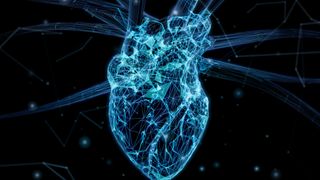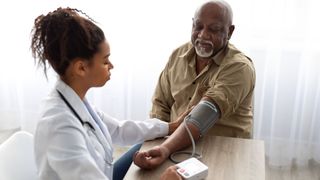Heart disease: Types, prevention and treatments
Heart disease is the leading cause of death in the United States, and encompasses a range of conditions. But are there ways to avoid it?

As can be expected from an organ responsible for getting blood throughout the body, the root of heart disease is when that blood flow is blocked.
Heart disease, or cardiovascular disease, encompasses a range of conditions, including blood vessel diseases such as coronary artery disease, problems with heart rhythm (arrhythmias) and congenital heart defects, according to the Mayo Clinic. It is the leading cause of death in both men and women in the United States, according to the Center for Disease Control and Prevention (CDC), claiming over 697,000 lives in the United States in 2020.
"The heart is a fascinating and complex organ which acts as the pump to facilitate blood circulation around the body," said Dr. Daniel Sado, a cardiology consultant for HCA Healthcare UK at London Bridge Hospital in England. "In order to achieve this, its key structures are muscle, coronary arteries and heart valves, with muscle contraction controlled by electrical pathways."
For around 100,000 beats per day, on average, these mechanisms work beautifully in unison to keep people alive, Sado told Live Science. "However, each bit can go wrong and lead to different diseases of the heart," he said.
Types and symptoms of heart disease
Coronary artery disease is the most common type of heart disease in the United States, according to the CDC. It occurs when cholesterol builds up in arteries — called plaque — narrowing the space blood can flow through, a condition called atherosclerosis.
In other words, "anything that blocks the vessel," said Dr. Lawrence Phillips, a cardiologist and assistant professor at NYU Langone Medical Center, New York City.
Ultimately, the narrowing can build up enough to cause chest pain and shortness of breath — called angina — or it can block the vessel completely, causing a heart attack. Heart attacks can also be caused by the rupture of a plaque that causes a blockage of the blood vessels, Phillips told Live Science. Over 1 million Americans suffer heart attacks each year, according to the American Heart Association.

Dr. Lawrence Phillips is an associate professor for the Department of Medicine at NYU Grossman School of Medicine. He is an assistant clinical director for strategic affairs at Leon H. Charney Division of Cardiology, a director of the Nuclear Cardiology Laboratory, an associate director of the Cardiovascular Disease Fellowship Program and a medical director at Outpatient Clinical Cardiology.
Another cause of heart disease is an arrhythmia, a condition where the heart beats too quickly (tachycardia), too slowly (bradycardia) or irregularly. Symptoms can include a fluttering feeling in the chest, racing heartbeat, slow heartbeat, chest pain or discomfort, shortness of breath, lightheadedness, dizziness, fainting (syncope) or near fainting, according to the Mayo Clinic.
Heart disease may also be caused by problems a person is born with, known as congenital heart defects. Symptoms of heart defects in children can include pale gray or blue skin (cyanosis), swelling in the legs, abdomen or around the eyes, and shortness of breath during feeding in infants (causing poor weight gain), according to the Mayo Clinic.
Less serious congenital heart defects may not be diagnosed until late childhood or adulthood. These defects are not immediately life threatening, and symptoms include becoming short of breath or tired easily during exercise or activity, as well as swelling in the hands, ankles or feet.
Other forms of heart disease can be caused by weak heart muscle, heart infections, or diseases of the heart valves.
How is heart disease diganosed?
Five symptoms can indicate when someone is having a heart attack and requires immediate emergency care, calling 911. These include pain in the jaw, neck or back; pain in the arms or shoulder; chest pain; lightheadedness or weakness; and shortness of breath, Phillips said.
Heart disease symptoms may differ for men and women, according to the Mayo Clinic. Men are more likely to have chest pain, while women are more likely to have shortness of breath, nausea and extreme fatigue.
Dr. John Whyte, the chief medical officer at WebMD, encouraged the use of risk estimators, such as the one developed by the American College of Cardiology. "It's also important to get lab tests which can include lipid panels, C-reactive protein as well as vitamin D," he said. "People need a baseline electrocardiogram [which records the electrical signal from the heart]. There's also numerous tests such as a 'stress test' which can be done on a treadmill with or without nuclear imaging.

A coronary computed tomography angiography can look at calcium deposits in a person's blood vessels, Whyte said, and a cardiac angiography looks for any blockages.
A number of factors play a role in heart disease risk. Some include family history and age (if a person is older or has relatives with heart disease, the risk goes up), but others are more controllable.
"Prevention is always far better than cure and so much of our work in cardiovascular disease is aimed at looking at lifestyle improvement," Sado said. "Of course, the benefits of doing this stretch far beyond the heart."
Much of the advice to avoid heart disease is the same health advice given for other conditions: stop smoking, exercise and eat a diet that is low in cholesterol and salt — cholesterol being the source of blockage and salt contributing to higher blood pressure. Other things to limit in the diet include saturated fats, which typically come from animal fats and oils, and trans fats, which occur in vegetable oil, but have largely been removed from the marketplace because of consumer demand.
According to the National Institutes of Health (NIH), diabetes can increase heart disease risk by as much as 100%, as the higher levels of glucose in the blood that are characteristic of diabetes can leave fatty deposits in blood vessels, which, like cholesterol plaques, can cause blockage of the heart.
Is heart disease preventable?
In addition to lifestyle changes, some treatments are available to help prevent heart disease. Many of these medications are designed to lower cholesterol.
There are two types of cholesterol. The first, LDL, is often referred to as "bad cholesterol" because it is the type that can build up and block blood vessels. The other, HDL, is often called "good cholesterol" because it is responsible for transporting LDL to the liver, ultimately removing it from the bloodstream.
Optimally, HDL cholesterol levels should be above 40 (measured in milligrams per deciliter of blood) and LDL cholesterol should be below 100, according to the CDC.
The Food and Drug Administration has approved a number of drugs for improving cholesterol levels. Perhaps the best-known are statins, which slow cholesterol production by the liver and speed up how fast it removes LDL cholesterol from the bloodstream.
Another class of drug to lower cholesterol is called bile acid sequestrants. These drugs remove bile acids from the body. Because the body produces these acids from LDL cholesterol, more LDL cholesterol will be broken down to replace them.
Niacin and fibrates are other drug classes for improving cholesterol levels. Both increase HDL cholesterol, while niacin lowers LDL cholesterol.
How is heart disease treated?
Surgical options can also treat heart disease. Coronary angioplasty is performed over one million times each year on patients in the United States, according to the NIH. In this procedure, a balloon is threaded into the affected blood vessel and inflated, pushing the plaque blocking the artery to the sides of the vessel. Sometimes, this procedure is accompanied by placement of a stent — a mesh tube designed to hold the blood vessel open.
"There are a lot of good treatment options today and tech can play a role in helping you eat healthy and stay physically active," Whyte said. "Smartwatches and smart devices, even devices like Lumen and continuous glucose monitors, can help you manage diet and activity. There are a range of medications to treat heart disease as well as devices such as stents."
This article is for informational purposes only, and is not meant to offer medical advice.
Additional resources
- To learn more about the causes of heart disease, check out the Mayo Clinic.
- The National Institutes of Health explains the risk factors for heart disease.
- For more facts and figures on heart disease, see the Centers for Disease Control and Prevention.
Sign up for the Live Science daily newsletter now
Get the world’s most fascinating discoveries delivered straight to your inbox.
- Lou MudgeHealth Writer